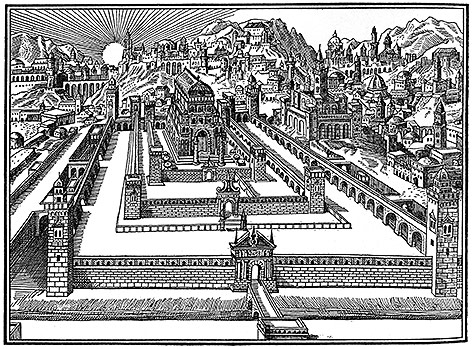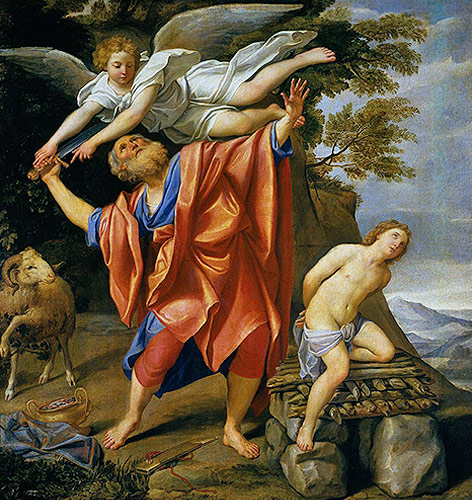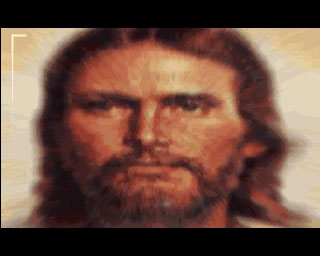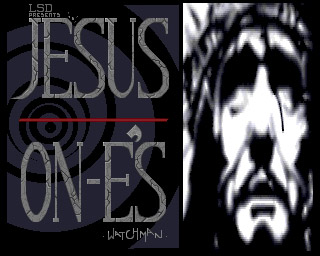Jesus is the true Easter lamb
category: residue [glöplog]
Sacrificial lamb and ancient rituals
He was the first, and at the same time, the last human sacrifice of the Christians: Jesus, who, according to Christian faith, had given himself for the sins of the world, became a substitute for all other forms of the sacrifice. His stylization as a sacrificial lamb through theology was linked to ancient rituals and at the same time turned them into a spiritual one.
The notion that Jesus' death on the cross was a sacrificial death and not a politically motivated murder or a judicial error formed in early Christianity: that is what the religious scholar Hans Gerald Hödl said in conversation with ORF.at. As a result, the Eucharist was also understood as a sacrificial meal.

Death penalty for political rebels
In principle, the crucifixion was simply "the death penalty for a political rebel", according to Hödl. "Then the followers of Jesus were convinced that he was resurrected." Theology thus made the unique sacrifice of a very uncultious event, which made all sacred sacrifices unnecessary (Heb 7:27). A break, because animal sacrifices were an important part of pre-oriental cults as well as the religious practice of Judaism.
In ancient Israel animals, often sheep and goats, but also cattle and pigeons, were sacrificed for slaughter. The priests were responsible for this in the temple. He was sacrificed once a year to the Passover, and there was the ongoing sacrificial enterprise. "In the post-exilic Israel the sacrifice at the temple has been centralized, but there have still been regulations for the private sacrifice," said Hödl. The early Christians were no longer involved in temple sacrificial rituals before the destruction of the second temple (70 AD by the Romans, note), but instead the Eucharist was used as a central ritual. "

Demarcation of the early Christians
In the course of a demarcation of the early Jewish Christians, the crucified Christ himself took the place of the temple cult. But one must assume that "Jesus and his disciples have followed the sacrificial cult," the religious scientist said. This is also evidenced by the Gospel when Jesus calls on the healed leper to go to the temple for sacrifice (Mt 8: 1-4).
The private sacrifice, for example, served the purpose of cleansing after a birth, as also reported by Mary (Lk 2,21-24). According to the Old Testament Bernhard Lang, the Eucharist replaced the private sacrifice. Hödl: "People have not sacrificed themselves. They bought the sacrifices at the temple, handed them over to the priest, and the priest made the sacrifice for them, kept a share, and returned the rest. "
Pious Jews from all parts of the empire came to the temple to be sacrificed. The exchange took place before the temple. The well-known temple purification of Jesus was by no means "a criticism of the sacrifice in itself, but of the form adopted by the exchange of money."

A "vegetarian cult"?
After the sacrificial ritual, parts of the animals were burned, others were eaten. The so-called "Mahlgemeinschaft" was essentially a principle in ancient Greece, and it served as a social bond.
In Christianity, the Passover meal was replaced by the consumption of bread and wine, whereby the early Christians could join cultivation deities in Mediterranean cults. The cults surrounding Dionysos as well as those around Demeter and Persephone (Kore myth) circulated around the change of the seasons, in the center stood field fruits. A little later, however, the refusal to sacrifice animals after Roman state riots led to persecutions for the Christians.
Example Isaac
A model for the human sacrifice Jesus is found in the Torah: the near-sacrifice of Isaac by his father Abraham. Christianity had very soon found a connection between Jesus and Isaac through the church fathers, according to Hödl. "Because of the fact that he carries the wood for the sacrifice on the mountain for the fire sacrifice, the wood soon became a link to the death of Christ." Unlike Jesus, God prevented the sacrificial death of Isaac at the last moment.
For the old philologist Gerhard Baudy, the Eucharist did not replace the private but the Passover, as expert Hödl said. The "bond of Isaac" (Genesis 22: 1--19) is often read as a substitution of man through the sacrifice of the beast. "Baudy argues that myths do not keep historical events, but explain social institutions at the time when they came into being."
In the religion of ancient Greece there are reports of human sacrifices in myths, but "it is very difficult to conclude that there really were human sacrifices," says Hödl. In many other cultures the practice of the human mind is demonstrated. Founding sacrifices, for example, are known from many religions: the sacrificed or sacrificed was installed in the house and was to act as a protector. The sacrifice could also be sent as a messenger to gods to give them something to do.
Easter lamb and scapegoat
Even before Easter, the scapegoat existed. According to the religious philosopher Rene Girard, the peaceful coexistence between people in a society can not be guaranteed because violence arises as a result of the conflict of desire that can be directed to the object. "A means of channeling this violence is to direct the aggressive impulses to a third, neutral object, a scapegoat," cited Hödl.
Thus the scapegoat, the object of violence, becomes a holy object, "the idea of the saint is born. It is, on the one hand, the accused who is blamed for the conflict; on the other hand, the salvation, the sacred, is also the result of the removal of the force which now acts externally, "says Hödl.
Ancient Greece also knew the principle of the scapegoat: In the Pharmacos ritual, a man, often an "ugly" man with physical distortions, was hunted out of the city, in order to "clean" the vicissitudes of the others.
"Ransom for many"
"According to Girard, the sacrifice was abolished by the prophetic criticism of the Old Testament, and finally by Jesus, who voluntarily made himself a scapegoat and thereby crossed the whole sphere to which the sacrifice belonged," says Hödl. In the Book of Isaiah (Isa 53: 7-10) the Lamb and the Atonement, which has sacrificed itself for the sins of men, are briefly mentioned. The whole life of Christ is, according to the Christian view, a voluntary sacrifice. He gives his life "as a ransom for many" (Mark 10, 45).
The intention of establishing Jesus once and for all as the ultimate sacrifice is already laid down in the Gospel of John: "Among the synoptics (the evangelists Matthew, Mark and Luke, note), the last supper was a Passover meal; To the day before. "There are two reasons for this: Firstly, it is more likely to be historically, because on the feast day no one had been hired. "Secondly, John can show the death of Jesus in which the lambs are sacrificed in the temple for the feast of the Passover, and introduce substitution: Jesus is the true Easter lamb."

http://slengpung.com/v3/show_photo.php?id=15185&ref=search&search=adok
He was the first, and at the same time, the last human sacrifice of the Christians: Jesus, who, according to Christian faith, had given himself for the sins of the world, became a substitute for all other forms of the sacrifice. His stylization as a sacrificial lamb through theology was linked to ancient rituals and at the same time turned them into a spiritual one.
The notion that Jesus' death on the cross was a sacrificial death and not a politically motivated murder or a judicial error formed in early Christianity: that is what the religious scholar Hans Gerald Hödl said in conversation with ORF.at. As a result, the Eucharist was also understood as a sacrificial meal.

Death penalty for political rebels
In principle, the crucifixion was simply "the death penalty for a political rebel", according to Hödl. "Then the followers of Jesus were convinced that he was resurrected." Theology thus made the unique sacrifice of a very uncultious event, which made all sacred sacrifices unnecessary (Heb 7:27). A break, because animal sacrifices were an important part of pre-oriental cults as well as the religious practice of Judaism.
In ancient Israel animals, often sheep and goats, but also cattle and pigeons, were sacrificed for slaughter. The priests were responsible for this in the temple. He was sacrificed once a year to the Passover, and there was the ongoing sacrificial enterprise. "In the post-exilic Israel the sacrifice at the temple has been centralized, but there have still been regulations for the private sacrifice," said Hödl. The early Christians were no longer involved in temple sacrificial rituals before the destruction of the second temple (70 AD by the Romans, note), but instead the Eucharist was used as a central ritual. "

Demarcation of the early Christians
In the course of a demarcation of the early Jewish Christians, the crucified Christ himself took the place of the temple cult. But one must assume that "Jesus and his disciples have followed the sacrificial cult," the religious scientist said. This is also evidenced by the Gospel when Jesus calls on the healed leper to go to the temple for sacrifice (Mt 8: 1-4).
The private sacrifice, for example, served the purpose of cleansing after a birth, as also reported by Mary (Lk 2,21-24). According to the Old Testament Bernhard Lang, the Eucharist replaced the private sacrifice. Hödl: "People have not sacrificed themselves. They bought the sacrifices at the temple, handed them over to the priest, and the priest made the sacrifice for them, kept a share, and returned the rest. "
Pious Jews from all parts of the empire came to the temple to be sacrificed. The exchange took place before the temple. The well-known temple purification of Jesus was by no means "a criticism of the sacrifice in itself, but of the form adopted by the exchange of money."

A "vegetarian cult"?
After the sacrificial ritual, parts of the animals were burned, others were eaten. The so-called "Mahlgemeinschaft" was essentially a principle in ancient Greece, and it served as a social bond.
In Christianity, the Passover meal was replaced by the consumption of bread and wine, whereby the early Christians could join cultivation deities in Mediterranean cults. The cults surrounding Dionysos as well as those around Demeter and Persephone (Kore myth) circulated around the change of the seasons, in the center stood field fruits. A little later, however, the refusal to sacrifice animals after Roman state riots led to persecutions for the Christians.
Example Isaac
A model for the human sacrifice Jesus is found in the Torah: the near-sacrifice of Isaac by his father Abraham. Christianity had very soon found a connection between Jesus and Isaac through the church fathers, according to Hödl. "Because of the fact that he carries the wood for the sacrifice on the mountain for the fire sacrifice, the wood soon became a link to the death of Christ." Unlike Jesus, God prevented the sacrificial death of Isaac at the last moment.
For the old philologist Gerhard Baudy, the Eucharist did not replace the private but the Passover, as expert Hödl said. The "bond of Isaac" (Genesis 22: 1--19) is often read as a substitution of man through the sacrifice of the beast. "Baudy argues that myths do not keep historical events, but explain social institutions at the time when they came into being."
In the religion of ancient Greece there are reports of human sacrifices in myths, but "it is very difficult to conclude that there really were human sacrifices," says Hödl. In many other cultures the practice of the human mind is demonstrated. Founding sacrifices, for example, are known from many religions: the sacrificed or sacrificed was installed in the house and was to act as a protector. The sacrifice could also be sent as a messenger to gods to give them something to do.
Easter lamb and scapegoat
Even before Easter, the scapegoat existed. According to the religious philosopher Rene Girard, the peaceful coexistence between people in a society can not be guaranteed because violence arises as a result of the conflict of desire that can be directed to the object. "A means of channeling this violence is to direct the aggressive impulses to a third, neutral object, a scapegoat," cited Hödl.
Thus the scapegoat, the object of violence, becomes a holy object, "the idea of the saint is born. It is, on the one hand, the accused who is blamed for the conflict; on the other hand, the salvation, the sacred, is also the result of the removal of the force which now acts externally, "says Hödl.
Ancient Greece also knew the principle of the scapegoat: In the Pharmacos ritual, a man, often an "ugly" man with physical distortions, was hunted out of the city, in order to "clean" the vicissitudes of the others.
"Ransom for many"
"According to Girard, the sacrifice was abolished by the prophetic criticism of the Old Testament, and finally by Jesus, who voluntarily made himself a scapegoat and thereby crossed the whole sphere to which the sacrifice belonged," says Hödl. In the Book of Isaiah (Isa 53: 7-10) the Lamb and the Atonement, which has sacrificed itself for the sins of men, are briefly mentioned. The whole life of Christ is, according to the Christian view, a voluntary sacrifice. He gives his life "as a ransom for many" (Mark 10, 45).
The intention of establishing Jesus once and for all as the ultimate sacrifice is already laid down in the Gospel of John: "Among the synoptics (the evangelists Matthew, Mark and Luke, note), the last supper was a Passover meal; To the day before. "There are two reasons for this: Firstly, it is more likely to be historically, because on the feast day no one had been hired. "Secondly, John can show the death of Jesus in which the lambs are sacrificed in the temple for the feast of the Passover, and introduce substitution: Jesus is the true Easter lamb."

http://slengpung.com/v3/show_photo.php?id=15185&ref=search&search=adok

Adok for fucks sake don't feek your own ego.
This Jesus sounds like an ok dude
I love satan, he is a cool guy who doesn't afraid of anything. Jesus is a hippie and kinda lame. Like Atari.
Satan says what he does, and does what he says! Satan 2020!
Quote:
Like Atari.


Quote:
Adok for fucks sake don't feek your own ego.
This.
By the way, didn't you quit?


